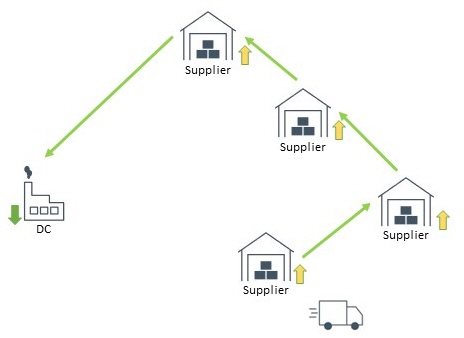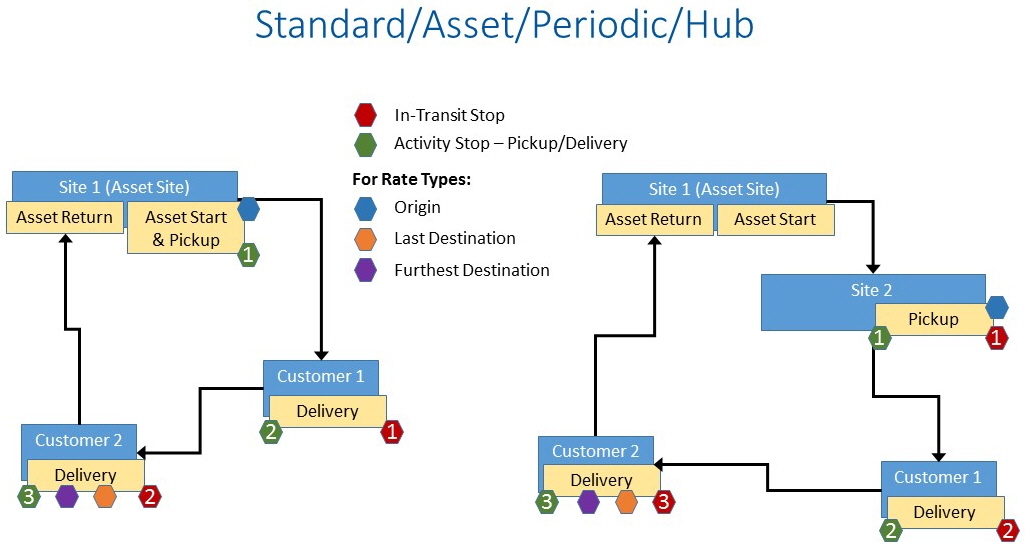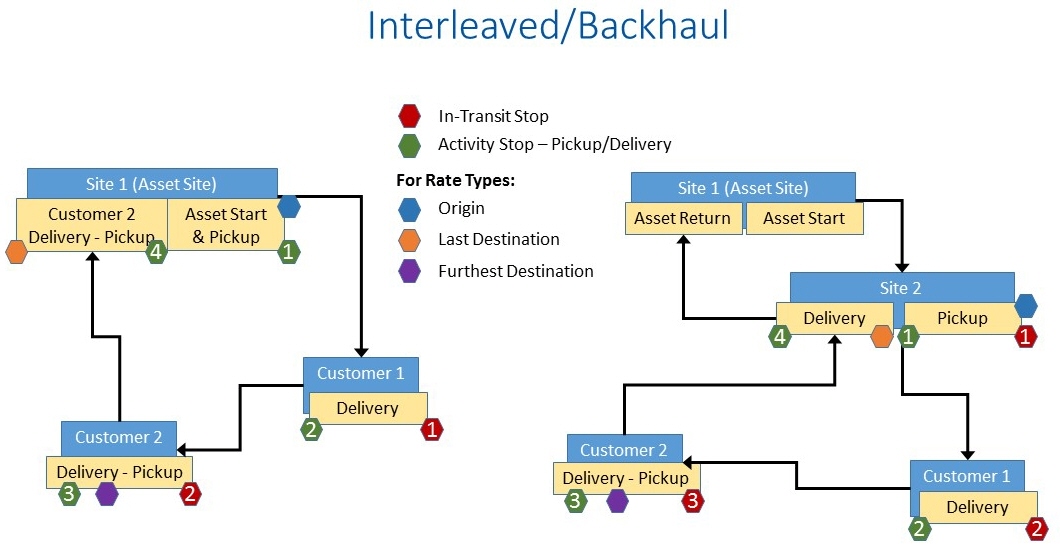Modeling transportation assets
As described earlier, you create transportation assets using the Transportation Asset and Asset Availability tables. The Transportation Asset table defines the physical characteristics of the asset type. These characteristics include:
- Asset capacity – Define the minimum and maximum fill levels of the asset.
- Average speed – The average speed is used to determine the travel time based on the calculated distance between locations on the route. You can override the travel time (and distance) using the Transit Matrix table.
- Routing limitations – Use these constraints to create more realistic routes in terms of time, distance, and other factors. For example, these constraints include:
- Maximum number of stops per route – This constraint is limited to stops that are related to shipment pickups and deliveries. For example, in an outbound Standard Optimization problem, if the site where vehicles are located is not the pool site, then the “Equipment Start” and “Equipment Return” stops are not counted in this constraint.
- Maximum total distance per route.
- Maximum travel time per route.
- Maximum out of route percent.
- Hours of service (HOS) regulations – Constrain the routes based on regulations on time for the assets.
- Asset availability – Use the Asset Availability table to define how many of each asset is available at the locations in your model.
- Asset site names – Assets can be defined at a location other than your pooling locations (pool sites).
- Stop definition and rate type examples - When assessing costs and constraints associated with stops, there are classifications for stops that are applied base on the problem type you use.
Asset capacity
You can define the maximum capacity of the asset type in terms of quantity, weight and volume. When Transportation Optimization is placing shipments onto assets, it considers the Quantity, Weight and Volume of these shipments. Shipments can be consolidated onto an asset until the most constraining of the capacity levels is reached.
Routing limitations
The Transportation Asset table includes a set of fields that enable you to establish limits on how routes are created using the asset. These constraints reflect practical operational considerations and help you create more realistic routes. For example, you can limit a single route to a maximum of 4 customer stops or to a maximum of 350 miles. Without these constraints, it would be possible to build artificially long routes.
Hours of service (HOS) regulations
Many parts of the world have specific regulations on the amount of duty time that can be incurred, how much time can be spent driving and the length of breaks. For example, the United States Department of Transportation (US DOT) has specific limits on these times. The Transportation Asset table has columns that you can use to model these regulations. For example:
- US DOT – Maximum Duty Time Per Shift = 14 hours (840 minutes), Maximum Drive Time Per Shift = 11 hours (660 minutes), and Minimum Break Time Between Shifts = 10 hours (600 minutes).
- UK regulations – Maximum Drive Time Per Shift = 9 hours (540 minutes), Minimum Break Time Between Shifts = 11 hours (660 minutes), Maximum Drive Time Within Shift = 4.5 hours (270 minutes, Minimum Break Time Within Shift = 45 minutes.
You can also control the Max Duty Time Before Break Time.
Asset availability
Once you have defined the asset types using the Transportation Assets table, you use the Asset Availability table to define:
- The number of available assets at a location during specific time windows.
- The priority of the assets, in the case where more than one asset is available at a location during a period of time.
You can define multiple assets types at a single location. For example, you may have both 48 foot trucks and 53 foot trucks available at your distribution center in Kansas City.
In addition, you can set up "floating assets" where the assets are not assigned to a specific site. This enables you to model the behavior of 3PL (third party logistics providers) vehicles where assets are not assigned to a domicile. This feature is primarily useful for inbound and interleaved models. In these cases, assets can start routes from any location in the model, such as a supplier on a multi-stop inbound route to a DC.

Asset availability groups
You can use Transportation Asset groups to apply the Available Units constraint from Asset Availability table across the assets in the group. For example, assume that you want to use no more than 5 assets for both the "48-Single" and "48-Team" assets. The setup for this constraint is as follows, using the Transportation Assets table, Groups and the Asset Availability table.
Create the two vehicles in the Transportation Assets table with Name values in the following format:
<AssetName>_AssetGroupX:Y
where X is the group number (you can have multiple asset groups) and Y is the number of available units. For example:
48-SINGLE_AssetGroup1:5
48-TEAM_AssetGroup1:5
Create a Transportation Asset Group where the Name is in the format:
AssetGroupX
where X is the group number. In this case, it is our first asset group, so the name is "AssetGroup1".
In the Asset Availability table, create records for the two assets at the appropriate site(s). Set the Available Units to the value of Y (the constraint across the members of the group. For example:
| Site | Asset | Available Units |
|---|---|---|
| DC1 | 48-SINGLE_AssetGroup1:5 | 5 |
| DC1 | 48-TEAM_AssetGroup1:5 | 5 |
In the Config_TO table, enter or update the following parameter.
| Parameter Name | Parameter Value | Status |
|---|---|---|
| AssetAvailabilityGroup | TRUE | Include |
When you run Transportation Optimization, no more than 5 assets can be used across the two members of AssetGroup1.
Asset site names
Assets can be defined at a location other than your pooling locations (pool sites). Transportation Optimization can use these assets as long as they are within the Asset Search Distance value (from the Sites table) from the pool site.
The location used as the asset site name does not need to be considered a pool site.
Stop definition and rate type examples
When assessing costs and constraints associated with stops, there are classifications for stops that are applied:
- In-transit stop – A location at which the asset stops after leaving its original site (the asset site) and returning to the asset site. This type of stop is used when assessing Max In-Transit Stops Per Route and Max Waiting Time At Location, and in-transit stop cost.
- Activity stop – A stop at which there is a pickup, a delivery or both. This type of stop is used when calculating service times.
In addition, stops are used when applying the Rate Type, as described in Transportation Optimization options.
The following illustrations show how stops are evaluated, for in-transit and activity stops, as well as the stop classifications for rate types. In the first graphic, you see the stops for standard optimization, asset optimization, periodic optimization and hub optimization:

In the second graphic, you see the stops for interleaved optimization and backhaul optimization:

Last modified: Friday May 12, 2023
